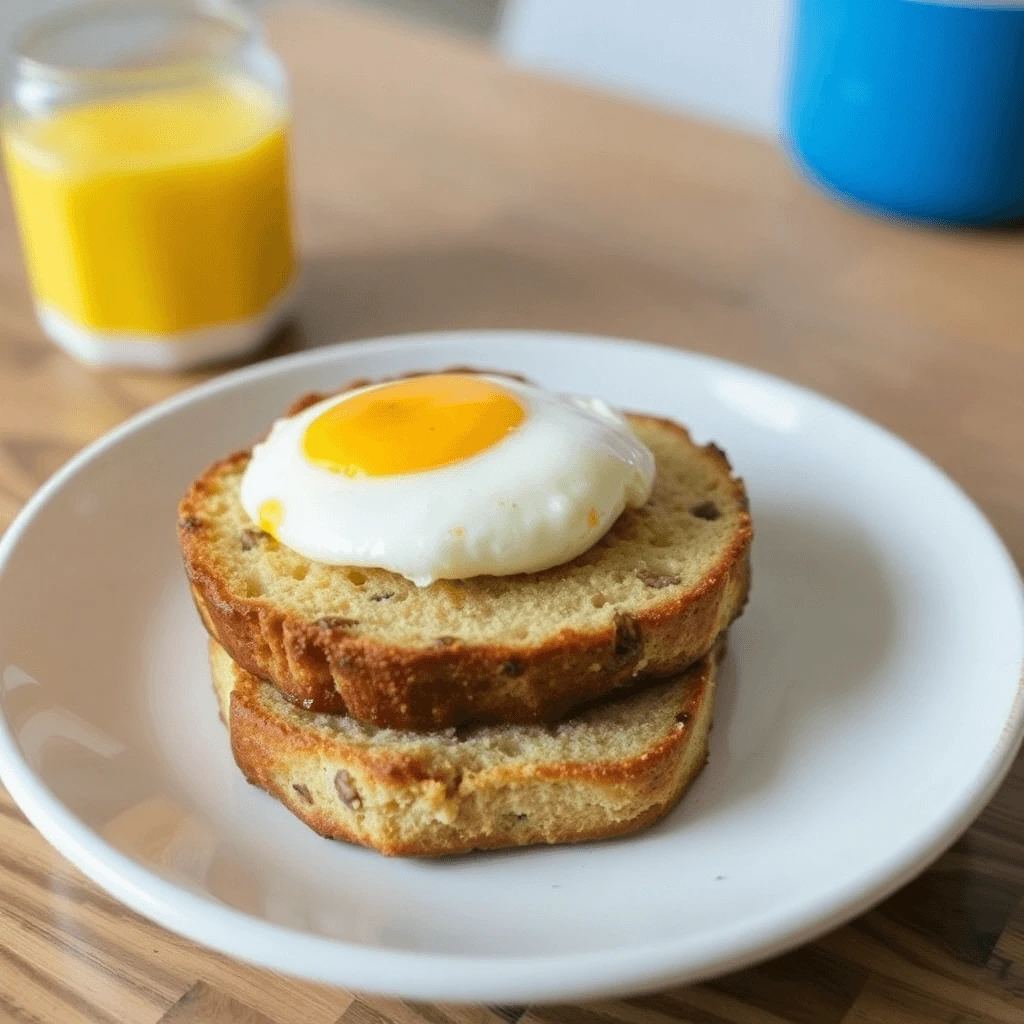Sourdough isn’t just for crusty loaves—it’s also the perfect ingredient for a delicious and wholesome breakfast! Whether you’re using an active sourdough starter or looking for creative ways to use up your discard, sourdough adds a rich, tangy flavor and a boost of nutrition to your morning meals. From fluffy pancakes to crispy waffles and hearty breakfast sandwiches, there are endless ways to incorporate sourdough into your breakfast routine.
In this guide, we’ll explore some of the best sourdough breakfast recipes that are easy to make and packed with flavor. Whether you’re a seasoned baker or just getting started with sourdough, these recipes will help you create a satisfying and nutritious breakfast that your whole family will love. Let’s get started!


Why Sourdough is Great for Breakfast
Sourdough Starter Guide
- Link to a reputable source explaining how to make and maintain a sourdough starter The Perfect Loaf – How to Make a Sourdough Starter
1. Digestive Health
Sourdough bread is made through a fermentation process that allows beneficial bacteria and wild yeast to thrive. This fermentation breaks down gluten and phytic acid, making the nutrients in the bread more accessible and easier to digest. Many individuals who experience mild gluten sensitivities find sourdough easier to tolerate than conventional bread. Starting your day with a slice of sourdough may help support a healthier gut.
2. Nutritional Benefits
Sourdough retains the nutritional benefits of whole grains, making it a good source of vitamins and minerals. Unlike many commercially produced breads, which may lack essential nutrients due to processing, traditional sourdough contains B vitamins, iron, magnesium, and antioxidants. Whole grain sourdough, in particular, offers additional fiber, which can help maintain steady energy levels and promote a feeling of fullness throughout the morning.
3. Low Glycemic Index
Another compelling reason to include sourdough in your breakfast is its low glycemic index (GI). Foods with a low GI are digested more slowly, leading to a gradual rise in blood sugar levels. This helps prevent energy crashes and keeps you fuller longer. Pairing sourdough with protein-rich toppings, such as eggs or nut butter, further stabilizes blood sugar, making it an excellent choice for maintaining energy levels during busy mornings.
4. Versatility in Toppings
Sourdough bread serves as a fantastic base for a variety of healthy toppings. You can make refreshing avocado toast topped with tomatoes and radishes, a savory breakfast sandwich with eggs and spinach, or sweet options like almond butter and banana. This versatility allows you to customize your breakfast according to your nutritional needs and flavor preferences, making it easier to maintain a balanced diet.
5. Flavor and Texture
The unique flavor profile of sourdough, characterized by its tangy taste and chewy texture, adds a delightful dimension to breakfast meals. The crisp crust and airy crumb of a well-made sourdough loaf enhance the overall breakfast experience, making it far more enjoyable than conventional bread. This enhanced flavor can make healthy eating more appealing and satisfying.
6. Sourdough as a Basis for Other Breakfast Foods
Beyond simple toast, sourdough can be used in a variety of breakfast recipes, such as pancakes, waffles, French toast, or even smoothies. This adaptability allows you to experiment with different meals while still reaping the health benefits of sourdough. Each of these variations can provide a unique twist on your morning routine.
In summary, sourdough bread is not only a delicious way to start your day but also offers numerous health advantages that are beneficial for maintaining energy levels, aiding digestion, and supporting overall wellness. Embracing sourdough in your breakfast can lead to healthier eating habits and a more enjoyable meal.
Essential Ingredients and Tools for Sourdough Breakfast Recipes

Health Benefits of Sourdough
- Link to a nutrition or health website that discusses the benefits of sourdough bread. Healthline – Why Sourdough Bread is Healthier Than Regular Bread
Essential Ingredients:
- Sourdough Bread:
- The star of any sourdough breakfast! Choose a high-quality loaf made from whole grains if possible. Look for a crusty exterior and a soft, airy interior. You can also experiment with different types of sourdough (such as wheat, rye, or multigrain) to diversify your meals.
- Fresh Eggs:
- A versatile and protein-packed ingredient, eggs are great for breakfast. They can be scrambled, poached, or fried and make for a delicious addition to a sourdough sandwich or toast. For a healthier option, consider using egg whites or incorporating veggies into your egg dishes.
- Avocado:
- Creamy and rich in healthy fats, avocado adds a satisfying texture and flavor to your breakfast. Spread mashed avocado on your sourdough toast or slice it for a topping. Avocados are also filled with vitamins, minerals, and fiber, making them a nutritious choice.
- Fruits and Vegetables:
- Fresh produce can elevate your sourdough breakfast. Consider using items like tomatoes, spinach, arugula, cucumbers, or radishes. Fruits such as berries, bananas, or apples can make excellent sweet toppings. Incorporating vegetables not only boosts nutrition but also enhances flavor and visual appeal.
- Nut Butters:
- Nut butters, such as almond butter or peanut butter, provide healthy fats and protein. They can be spread on sourdough for a filling breakfast option and are especially delicious when paired with sliced fruit like bananas or apples.
- Cheese:
- Cheese can enhance flavor and add creaminess to your breakfast. Options like feta, goat cheese, or a sharp cheddar work well in savory dishes. Consider adding cheese to omelets or using it as a topping on your sourdough toast.
- Herbs and Spices:
- Fresh herbs (like basil or cilantro) and spices (like red pepper flakes or black pepper) can transform the flavor of your dishes. Sprinkle them on top of eggs, avocado toast, or baked goods to add depth and freshness.
- Oils and Spreads:
- A drizzle of olive oil or a splash of balsamic vinegar can brighten up your sourdough breakfast creations. Various spreads, such as hummus or pesto, can also offer unique flavor profiles and additional nutrients.
Essential Tools:
- Quality Knife:
- A sharp bread knife is essential for slicing your sourdough without crushing the loaf. The right knife will give you clean, even slices for your breakfasts.
- Toaster or Toaster Oven:
- A toaster or toaster oven is necessary for quickly turning your sourdough slices crispy and golden. This texture adds a satisfying crunch and can enhance flavors when topped.
- Skillet or Non-stick Pan:
- To cook eggs or sauté vegetables, a good skillet or non-stick pan is required. Cast iron or stainless steel pans are also great for evenly cooked breakfast items.
- Mixing Bowls:
- Having a variety of mixing bowls on hand is useful for preparing ingredients (like whisking eggs, mixing spreads, or combining salads) to accompany your sourdough.
- Spatula:
- A good spatula is essential for flipping and serving eggs or turning vegetables as they sauté. Silicone spatulas can be helpful for non-stick pans to avoid scratching.
- Measuring Cups and Spoons:
- Accurate measurements will ensure consistent and delicious results, especially if you’re trying new recipes for spreads, toppings, or egg mixtures.
- Cutting Board:
- Invest in a sturdy cutting board to protect your countertops while preparing your ingredients and slicing your sourdough.
- Storage Containers:
- If you’re prepping ingredients in advance, having airtight storage containers will help keep produce and leftovers fresh until you’re ready to assemble your breakfast.
- Blender or Food Processor:
- If you’re making smoothies or dips (like hummus or guacamole) to accompany your breakfast, a blender or food processor can be invaluable.
- Serving Plates:
- Presenting your beautiful creations on attractive serving plates can enhance the breakfast experience. Consider having various sizes for individual servings or family-style meals.
Conclusion
Equipped with the right ingredients and tools, you can create a variety of delicious and nutritious sourdough breakfast recipes. The combination of wholesome foods and essential kitchen equipment sets the foundation for a fulfilling breakfast routine that supports healthy living and culinary creativity.
Delicious Sourdough Breakfast Recipes to Try
1. Avocado Toast with Poached Eggs
Avocado toast is a brunch favorite, and when paired with a perfectly poached egg, it becomes a nutritional powerhouse.
- Ingredients: Fresh sourdough bread, ripe avocado, eggs, salt, pepper, red pepper flakes, and lemon juice.
- Instructions:
- Toast a slice of sourdough until golden brown.
- Smash the avocado with a fork and mix in a bit of lemon juice, salt, and pepper.
- Poach an egg by simmering water and adding a splash of vinegar. Gently crack the egg into the water and cook for 3-4 minutes.
- Spread the avocado mixture on the toast, top with a poached egg, and sprinkle with red pepper flakes.
2. Sourdough French Toast
Transform your stale sourdough into delicious French toast for a sweet breakfast treat.
- Ingredients: Sourdough bread, eggs, milk, cinnamon, vanilla extract, and maple syrup.
- Instructions:
- In a bowl, whisk together eggs, milk, cinnamon, and vanilla.
- Dip slices of sourdough in the mixture, coating both sides.
- Heat a non-stick skillet with a bit of butter and cook the bread until golden brown on both sides.
- Serve with a drizzle of maple syrup and fresh fruit.
3. Sourdough Breakfast Sandwich
A hearty breakfast sandwich is a perfect way to start the day.
- Ingredients: Sourdough bread, eggs, cheese (like cheddar or gouda), cooked bacon or sausage, and spinach or arugula.
- Instructions:
- Toast slices of sourdough or grill them lightly.
- Cook the egg to your preference (fried, scrambled, or even a sunny-side-up).
- Layer the egg on the sliced sourdough, add cheese, bacon or sausage, and a handful of greens.
- Top with another slice of sourdough or enjoy open-faced.
4. Sourdough and Vegetable Frittata
A frittata is a wonderful way to incorporate leftover vegetables and make a filling breakfast.
- Ingredients: Sourdough bread, eggs, milk, bell peppers, onions, spinach, cheese, salt, and pepper.
- Instructions:
- Preheat your oven to 375°F (190°C).
- In a skillet, sauté onions and bell peppers until soft. Add spinach and cook until wilted.
- In a bowl, whisk together eggs, milk, salt, and pepper. Tear sourdough into pieces and mix into the egg mixture.
- Pour the egg-vegetable mixture into the skillet, sprinkle cheese on top, and transfer to the oven.
- Bake for 20-25 minutes or until the eggs are set. Slice and serve warm.
5. Sourdough Toast with Nut Butter and Banana
This simple yet satisfying breakfast is perfect for busy mornings.
- Ingredients: Sourdough bread, almond or peanut butter, banana, and honey (optional).
- Instructions:
- Toast a slice of sourdough to your desired crispness.
- Spread a generous layer of nut butter on the toast.
- Slice a banana and arrange on top of the nut butter. Drizzle with honey if desired for extra sweetness.
6. Sourdough Granola
Turn your stale sourdough into a crunchy granola mix for a unique take on breakfast.
- Ingredients: Stale sourdough bread, oats, nuts (almonds, walnuts), honey or maple syrup, and dried fruit.
- Instructions:
- Preheat your oven to 350°F (175°C).
- Tear stale sourdough into small pieces and combine it with oats, chopped nuts, and dried fruit.
- In a saucepan, warm honey or maple syrup until liquid, then mix with the dry ingredients. Spread on a baking sheet.
- Bake for 20-25 minutes, stirring occasionally until golden brown. Allow to cool before serving with milk or yogurt.
7. Savory Sourdough Pancakes
These savory pancakes can incorporate fresh herbs or cheese for a tasty twist.
- Ingredients: Sourdough starter (or flour if you don’t have a starter), eggs, milk, herbs (like chives or parsley), and cheese.
- Instructions:
- In a bowl, mix sourdough starter (or flour), eggs, and milk until just combined. Fold in herbs and cheese.
- Heat a skillet with butter and pour in batter to form pancakes. Cook until bubbles form, then flip to cook the other side.
- Serve with a dollop of yogurt or sour cream.
8. Sourdough Smoothie Bowl
For a refreshing twist, try adding a sourdough element to a smoothie bowl.
- Ingredients: Sourdough breadcrumbs (toasted), your choice of fruits (bananas, berries, spinach), yogurt or almond milk, and toppings like nuts and seeds.
- Instructions:
- In a blender, combine fruits, yogurt, and a splash of almond milk until smooth.
- Pour into a bowl, top with toasted sourdough breadcrumbs, nuts, seeds, and extra fruits for texture and flavor.
Conclusion
These delicious sourdough breakfast recipes not only highlight the versatility of sourdough bread but also offer a range of flavors and nutritional benefits. Whether you prefer a savory meal to kickstart your day or a sweet treat to indulge in, incorporating sourdough into your breakfast routine is a fantastic way to enjoy a satisfying start to your morning!
Tips for Perfect Sourdough Breakfast Dishes
Creating delicious and satisfying sourdough breakfast dishes requires a few key techniques and considerations. Here are some tips to help you elevate your sourdough breakfasts:
1. Choose Fresh Sourdough Bread
- Opt for Quality: When possible, choose a loaf of freshly baked sourdough from a local bakery. The flavor and texture will be far superior to store-bought options.
- Stale Sourdough is Still Good: If your sourdough loaf is getting stale, don’t discard it! Stale bread works beautifully in recipes like French toast or bread pudding, as it absorbs liquids better without falling apart.
2. Enhance Flavor with Toppings
- Experiment with Spreads: Elevate your toast or sandwiches by using flavorful spreads. Consider options like hummus, pesto, cream cheese, or flavored butters to add depth to your dishes.
- Add Fresh Herbs and Spices: Fresh herbs (like basil, cilantro, or chives) and spices (to taste) can brighten your breakfast. A sprinkle of red pepper flakes or smoked paprika can add a unique twist.
3. Master Cooking Techniques
- Perfect Poaching: For poached eggs, use fresh eggs and add a splash of vinegar to the boiling water. This helps the egg whites to coagulate, resulting in a nicer shape.
- Toast for Texture: Whether using a regular toaster or a skillet, toasting sourdough can enhance its texture and flavor. A little crunch can make a noticeable difference to your dishes.
4. Incorporate Nutrient-Rich Ingredients
- Balance Your Meal: Include a variety of food groups in your sourdough breakfasts. Incorporate proteins (like eggs, cheese, or nut butter), healthy fats (such as avocado), and fiber (from fruits and vegetables) to create a balanced meal.
- Use Whole Ingredients: Opt for whole fruits and vegetables rather than processed options. Fresh, seasonal ingredients will not only taste better but also provide more nutrients.
5. Make Ahead for Convenience
- Prep in Advance: If you’re on a tight schedule, consider prepping ingredients the night before. Chop vegetables, slice fruits, or even make overnight oats to save time in the morning.
- Batch Cooking: Prepare larger quantities of breakfast dishes (like frittatas or pancakes) to freeze and reheat throughout the week. This makes for quick and easy breakfasts that still feel homemade.
6. Add Sweetness Responsibly
- Natural Sweeteners: If you’re making something sweet, consider using natural sweeteners like honey, maple syrup, or agave nectar instead of refined sugars. These options can enhance flavor without overly sweetening your dish.
- Use Seasonal Fruits: Top your sourdough dishes with seasonal fruits for a natural sweetness. Berries, bananas, or stone fruits add color and flavor.
7. Know Your Bread’s Characteristics
- Understand the Crust and Crumb: The thickness of the crust and the texture of the crumb will impact how it interacts with toppings. Heavier toppings may work better on a denser loaf, while lighter toppings may be better suited to a lighter bread.
- Consider Hydration Levels: The moisture content in your sourdough can affect how it toasts or holds up in dishes. Experimenting with different hydration levels in your own baking may lead to preferred results based on your recipe.
8. Mind the Balance of Heat
- Control Cooking Temperatures: When cooking eggs or pancakes, ensure your skillet is not too hot to prevent burning. Moderate your heat to cook eggs evenly or to achieve the perfect golden-brown pancake without overcooking.
- Two Cooking Methods: For a twist, consider using two cooking methods for different textures. For example, you can grill your sourdough and then top it with a poached egg for a contrast of textures.
9. Presentation Matters
- Plate with Care: Take a moment to arrange your breakfast aesthetically on the plate. Whether it’s a garnish of herbs or a drizzle of sauce, a well-presented plate can enhance your breakfast experience.
- Use Color Wisely: Incorporating colorful ingredients not only makes your meal more visually appealing but also signals nutritional diversity. Consider the color palette of your plate, balancing greens, reds, and yellows.
10. Taste and Adjust
- Season as You Go: Always taste your dishes during preparation. Adjust seasoning with salt, pepper, and other flavor enhancers to ensure balance.
- Get Creative: Feel free to experiment and adapt recipes to suit your taste preferences. Sourdough breakfast dishes are versatile, so don’t hesitate to mix and match ingredients!
Conclusion
With these tips in mind, you can create perfect sourdough breakfast dishes that are not only delicious but also visually appealing and nutritious. By experimenting with flavors, mastering techniques, and incorporating fresh ingredients, you can enjoy a wonderful start to your day with each meal. Embrace the versatility of sourdough and let your creativity shine in the kitchen!
Final Thoughts & More Sourdough Ideas
Sourdough is more than just a baking trend; it’s a culinary journey that not only delights the palate but also nurtures creativity in the kitchen. As we wrap up this exploration into sourdough breakfast dishes, here are some final thoughts and additional ideas to keep your sourdough game strong:
1. The Joy of Fermentation
Fermenting your dough not only contributes to the unique flavor profile of sourdough but also offers health benefits. The fermentation process increases the bioavailability of nutrients, making it easier for your body to absorb them. Sourdough is also gentler on your digestive system, thanks to lower gluten content compared to conventional bread.
2. Experimenting with Flavors
Sourdough is highly adaptable, allowing you to experiment with various ingredients:
- Herbs and Spices: Add fresh or dried herbs (like rosemary or thyme) to your dough for a fragrant twist. Spice blends such as za’atar or everything bagel seasoning can also elevate the flavor.
- Cheese Add-ins: Incorporate shredded cheese into your sourdough for an extra layer of flavor. Cheddar, feta, or even blue cheese can complement other breakfast items beautifully.
- Sweet Variations: For sweeter applications, consider adding dried fruits (like cranberries or raisins), nuts, or spices (like cinnamon and nutmeg) incorporated into your dough.
3. Sourdough-Based Snacks
Sourdough isn’t just for breakfast! Here are some other delicious ideas:
- Sourdough Crackers: Create thin, crispy crackers using sourdough starter. Roll out the dough, cut it into shapes, and bake them until golden brown. These make for great snacks.
- Sourdough Pizza Bases: Use your sourdough for pizza night! The crust will be tangy and flavorful. Top it with your favorite ingredients to create an artisanal pizza.
- Sourdough Pretzels: Experiment with making soft pretzels using sourdough. The dough’s fermentation can give it a unique taste, and you can top them with coarse sea salt or everything seasoning.
4. Sourdough Leftovers Transformation
Don’t let stale sourdough go to waste! Here are a few ways to repurpose it:
- Bread Pudding: Make a delightful bread pudding by soaking chunks of stale sourdough in a custard mixture and baking it until golden and set. Serve with a drizzle of caramel sauce or a dusting of powdered sugar.
- Sourdough Croutons: Transform stale bread into flavorful croutons. Cube the bread, toss with olive oil and seasonings, and bake until crispy. They’re perfect for salads and soups.
- Sourdough Dumplings: Use leftover starter to create savory dumplings that can be added to soups for added texture.
5. Get Your Kids Involved
Baking sourdough can be a fun and educational activity for kids. Engage them in the process:
- Teach Them About Fermentation: Explain the science behind fermentation and how yeast works. Kids will get a kick out of seeing the dough rise!
- Creative Toppings: Allow your children to choose their favorite toppings for sourdough toast or mini pizzas, promoting their creativity and encouraging them to eat their creations.
- Kid-Friendly Recipes: Simplify the process with easy recipes like sourdough pancakes or waffles, where they can help with mixing and measuring.
6. Join the Sourdough Community
The sourdough baking community is vast and full of passionate bakers willing to share tips, recipes, and inspiration:
- Online Forums and Groups: Join social media groups or forums dedicated to sourdough. Sharing experiences and learning from others can be incredibly enriching.
- Participate in Workshops: Look for local baking classes or online workshops where you can deepen your skills and meet other sourdough enthusiasts.
- Experiment & Share: Don’t hesitate to share your own sourdough creations on social media—it’s a great way to connect with fellow bakers and inspire others.
7. Explore New Recipes
Sourdough is a versatile bread, and there are endless recipes to explore. Here are a few ideas:
- Sourdough Bagels: Try making your own bagels using sourdough for that unique chewy texture.
- Sourdough Biscuits: Mix up your breakfast routine with sourdough biscuits, perfect for serving with gravy or as a breakfast sandwich base.
- Sourdough Cakes: Experiment with baking cakes that incorporate sourdough, which can add moisture and depth to flavors.
Conclusion
Sourdough is not just a type of bread; it embodies a rich tradition and a chance for creativity in the kitchen. By exploring different applications and techniques, you can transform your sourdough into a variety of delicious dishes. Whether you stick to classic recipes or venture into more innovative territories, remember to enjoy the process. As you continue your sourdough journey, let curiosity guide you, and feel free to experiment, taste, and share your creations. Happy baking!

